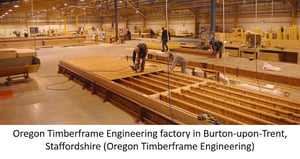
Britain faces the dual crises of a serious housing shortage and a construction industry that's losing skilled workers faster than it recruits them. Offsite construction...
While offsite construction offers many advantages to a developer, its use in Britain is mostly confined to large-scale developments. Here we discuss the constraints to its wider adoption, including poor understanding of the advantages among people who commission developments, an overly restrictive planning system and a lack of industry capacity.
This post is part of our series on offsite construction techniques. The others are:
Modern offsite construction techniques: an overview
Offsite construction: advantages in costs and efficiency
Can offsite construction solve Britain's housing crisis?
We opened our post on the advantages of offsite construction by quoting a paper by Dale Steinhardt and Karen Manley on the Queensland University of Technology, which compared the uptake of offsite construction techniques between several countries [PDF] and concluded that Britain was one of the 'laggard countries' in offsite construction, with less than 5% of its construction done offsite.
The low uptake might appear surprising given the many advantages, so we need to consider its limitations to understand Britain's 'laggard' status. First on the list are the limits to the advantages themselves: from the perspective of a developer bidding for a contract, the advantages that matter are the ones that directly affect the bottom line. Many of the advantages of offsite over onsite techniques, such as better working  conditions, lower waste and less local disruption and pollution, are advantages to society that won't necessarily appear on a tender. They are only likely to be realised if society, in the form of local authorities and central government, make it their mission to see that they are realised.
conditions, lower waste and less local disruption and pollution, are advantages to society that won't necessarily appear on a tender. They are only likely to be realised if society, in the form of local authorities and central government, make it their mission to see that they are realised.
There are also a number of more direct constraints that will need to be addressed before offsite construction techniques are more widely used in Britain.
An article posted by the construction insurance specialists CRL suggested that many of the people who commission new developments simply have an outdated idea of what offsite construction actually is. Instead of thinking of cutting-edge developments like Creekside Wharf [PDF] in Greenwich, they think of portacabins:
The majority of those commissioning new buildings are in the baby-boomer generation. They have negative memories of temporary classroom buildings and need to understand the difference between these structures and offsite construction in the UK. "The Major Issues Holding Back Offsite Construction in the UK 08Oct18".
Entertaining as it is to wonder how many boomers have read that and objected to being characterised as latter-day Colonel Blimps, it would be more instructive to know how many of the people who handle the tenders for building projects know what modern offsite construction is now capable of. Sadly, no such figures are available.
Even if a project commissioner's shuddersome memories of drafty primary school classrooms don't put them off offsite techniques, they won't be able to take full advantage of them unless they know what they're taking full advantage of. A guide to offsite construction techniques [PDF] published by Buildoffsite points out that to make best use of offsite techniques, they should be considered from the beginning of the planning of a development which can only happen if the planners see them as worth considering in the first place.
 As an example of why it’s important, the Buildoffsite quote the redevelopment of Birmingham New Street railway station as part of the Birmingham Gateway project. The original design used a traditional approach before it was realised that offsite techniques would cause far less disruption to the operation of the station. Had the offsite techniques been considered as a possibility from the outset rather than as a solution to a problem that emerged from the early designs, the time and money spent on the initial design would have been saved.
As an example of why it’s important, the Buildoffsite quote the redevelopment of Birmingham New Street railway station as part of the Birmingham Gateway project. The original design used a traditional approach before it was realised that offsite techniques would cause far less disruption to the operation of the station. Had the offsite techniques been considered as a possibility from the outset rather than as a solution to a problem that emerged from the early designs, the time and money spent on the initial design would have been saved.
For offsite techniques to be considered in any and every development, the people involved in the initial planning need to know what the capabilities, advantages and indeed limitations of those techniques are from the outset. The Birmingham Gateway experience suggests that the information has yet to find its way into every corner it needs to be found.
If the perception problem is as widespread as CRL suggest, it probably extends to the officials responsible for issuing planning permissions. The planning system has come in for a considerable amount of criticism in recent years, much of it summarised by Christian Hilber, an economist at the London School of Economics, who identified the planning system as a 'main cause of the excessively high house prices' in an article based on evidence he gave to the Treasury Committee in 2016.
Hilber's criticisms and proposed reforms [PDF] are aimed mostly at lowering house prices and bringing home ownership within reach of people who do not already own or expect to inherit property. However, the faster and cheaper offsite techniques have often been touted as key to expanding home ownership and one of Hilber's criticisms impacts directly on offsite construction: 'a consultation process that gives significant weight to NIMBY pressures'. Those pressures often take the form of objections to changing the aesthetic of an area, which means that new houses are required to look like the houses already in the locale.
 Many offsite methods are designed around the developer or future owner choosing the design of the building, which will be constructed out of modern materials. For example, the German HUF House uses triple-insulated glass supported by a timber frame while Tufeco builds uses ceramic panels made of recycled glass. Such buildings are comfortable, energy-efficient and allow the owner considerable scope to design their own home, but stick out like a sore thumb in an English town full of Georgian terraces or Victorian redbrick. A planning system that prioritises uniform appearance and protected views is bound to take a dim view of such buildings.
Many offsite methods are designed around the developer or future owner choosing the design of the building, which will be constructed out of modern materials. For example, the German HUF House uses triple-insulated glass supported by a timber frame while Tufeco builds uses ceramic panels made of recycled glass. Such buildings are comfortable, energy-efficient and allow the owner considerable scope to design their own home, but stick out like a sore thumb in an English town full of Georgian terraces or Victorian redbrick. A planning system that prioritises uniform appearance and protected views is bound to take a dim view of such buildings.
It is possible for a project to use offsite methods and at least appear traditional, and firms like Wetherby offer a range of veneers that make a house constructed using modern offsite methods look like it hasn't been disturbed since Queen Victoria was cavorting with Prince Albert. However pleasing such veneers may be to the eye of a neighbour or planning official, they do add to the time and the cost of construction without adding anything to the comfort or energy efficiency of the house, which begs the question of whether the veneer should be a planning priority at a time when Britain is facing a housing shortage.
Hilber's criticisms were echoed in the Department for Communities and Local Government (DCLG)'s 2017 white paper titled Fixing Our Broken Housing Market, which was scathing about the lack of forward planning shown by many planning authorities:
At the end of January 2017, 34 local planning authorities had not published a local plan for consultation, despite having had over twelve years to do so. P22.
The DCLG wants local authorities to put as much emphasis on planning residential developments as on assessing individual planning applications. Given that Britain has an acute housing shortage and that offsite techniques offer rapid construction of high-quality homes with less local disruption than traditional onsite techniques, there are strong reasons for a local authority to actively encourage offsite construction in their local development plans.
 Without a development plan to follow, the question posed to a planning official reviewing a proposal is not 'does this fit into our plans for developing this community?' but 'should I approve this building?' The latter question inevitably gives less weight to reasons why than to reasons why not, which include the possibility that it might spoil someone's view.
Without a development plan to follow, the question posed to a planning official reviewing a proposal is not 'does this fit into our plans for developing this community?' but 'should I approve this building?' The latter question inevitably gives less weight to reasons why than to reasons why not, which include the possibility that it might spoil someone's view.
If the priority is to maintain an aesthetic defined by Georgian building techniques, the solution is likely to be to use the same techniques to build any new houses rather than to embrace more modern techniques like offsite construction. There will certainly be no room for the bespoke homes that offsite construction can offer future occupiers.
In Fixing Our Broken Housing Market, the Department for Communities and Local Government makes a commitment to 'consider how the operation of the planning system is working for modern methods of construction (MMC) developments' but gives no detail on how or when that will translate into changes in policy.
As many of the benefits of moving construction offsite, such as reduced time onsite and reduced traffic, are to the local community, it is unfortunate that so many local authorities are leading Britain's laggardliness rather than considering ways in which discarding it might benefit the communities they represent.
Given that major developers such as Laing O'Rourke have invested in factory-based production, it may seem strange to talk about the UK's lack of offsite building capacity. However, the large developers' factories are geared toward large buildings such as supermarkets and tower blocks, while most residential construction in the UK is on a much smaller scale. Hence the Department for Business, Energy and Industrial Strategy (BEIS) response to the House of Lords Science and technology committee:
There is an opportunity for the UK to maintain its position at the forefront of off-site manufacture globally in the commercial and high-rise residential sectors. However, we are concerned that the UK lags significantly behind other countries in the low-rise residential sector. P5.
In the BEIS document, the statement is blocked out in bold in case its significance is missed and, being a government statement, carries the mandatory upbeat tone. Even in the high-rise sector, it's hard to see how the UK is sharing the forefront with China and Japan.
The reasons behind the UK's laggardly position in the low-rise sector are discussed in the Construction Leadership Council's review written by Mark Farmer, and the solution - and the consequences of not adopting it - is contained in its subtitle: Modernise or Die. Farmer describes the structural fragmentation of the construction industry, in which any given project is likely to involve many small firms contracted to carry out a particular task, and in which many of the people employed by those firms are only employed for as long as it takes to complete it.
These firms have neither the capital to build a factory nor regular enough work to be confident they'll keep it busy enough to pay for its overheads, which is why offsite construction has largely been left to the large developers who can afford to keep a their factories busy. Those large developers justify the BEIS's view that Britain is a leader in at least part of the offsite manufacturing sector, but have little to do with the small firms that make up the backbone of Britain's construction industry.
If the government actually acts on its commitments to reform the planning system and encourage offsite manufacturing, the smaller firms that make up so much of the UK construction industry will need to keep up with a dramatic shift in the market. It's worth  bearing in mind that in Japan, which is a world leader in offsite construction, most prefabricated construction has consolidated around a market dominated by ten large manufacturers [PDF] with little space for the smaller developers. 'Modernise or Die' is more than a subtitle.
bearing in mind that in Japan, which is a world leader in offsite construction, most prefabricated construction has consolidated around a market dominated by ten large manufacturers [PDF] with little space for the smaller developers. 'Modernise or Die' is more than a subtitle.
Farmer suggests a 'factory sharing' program, in which a number of small businesses could share the investment, and hence the risk, in operating a single manufacturing facility. One major bar to that approach was stated in a submission to the House of Lords Science and Technology Committee [PDF] by the engineering firm ARUP:
Construction is a highly competitive and litigious industry; fundamentally the industry isn’t overly trusting of each other. P16.
The question of how to persuade firms to collaborate comes up several times in the submissions to the same committee. One solution was suggested by Diana Montgomery, chief executive of the Construction Products Association, who pointed out that the government is a major client of the construction industry and could add in incentives to collaboration and modernisation when issuing tenders.
The idea of using government contracts to drive the construction industry is a major part of Singapore's building program and has led to a substantial expansion of offsite construction. Government and industry have always worked together more closely in Singapore than in Britain but the idea of incentivising offsite construction and collaboration was embraced in the government's response, albeit without stating specifically how that would be done.
The advantages of offsite construction add up to a strong reason for Britain to stop being a laggard, but the constraints will need to be overcome.
 Fortunately, the description of most of the constraints contains their solutions. The most important part of the solution was suggested in the evidence given by Richard Harrington, then the BEIS minister, to the Lords Committee: 'A quarter to a third of all construction is government funded one way or the other'. That means that the government is positioned to take a lead that is not going to emerge organically from an industry as fragmented as construction.
Fortunately, the description of most of the constraints contains their solutions. The most important part of the solution was suggested in the evidence given by Richard Harrington, then the BEIS minister, to the Lords Committee: 'A quarter to a third of all construction is government funded one way or the other'. That means that the government is positioned to take a lead that is not going to emerge organically from an industry as fragmented as construction.
If the BEIS, and the government in general, is as serious about embracing offsite construction as it claims to be, we suggest that it will need to take the following steps:
Our next post discusses the potential role for offsite construction in resolving Britain's housing shortage.
If you have any further questions about offsite construction, or how Atamate building intelligence can be incorporated into an offsite project, please ask us on the form below and we'll be happy to answer.

Britain faces the dual crises of a serious housing shortage and a construction industry that's losing skilled workers faster than it recruits them. Offsite construction...

The British construction industry has been slow to adopt offsite techniques in spite of the savings in time and money they offer to developers when compared to...